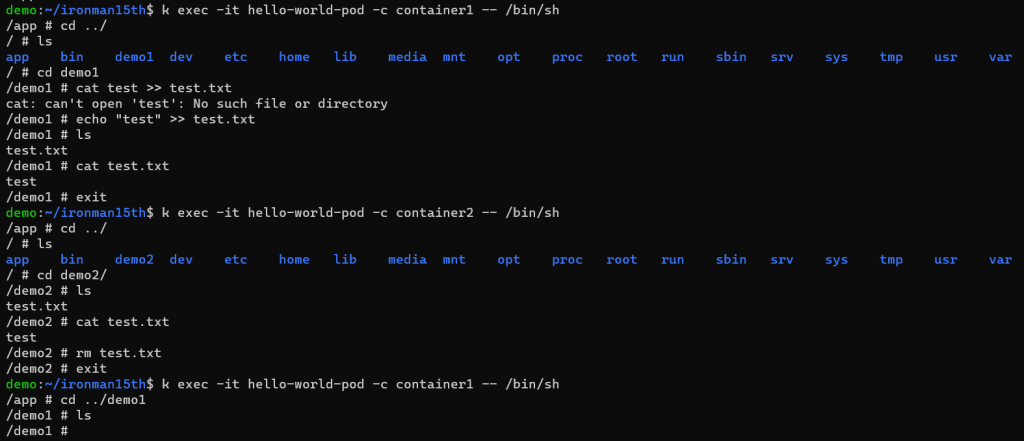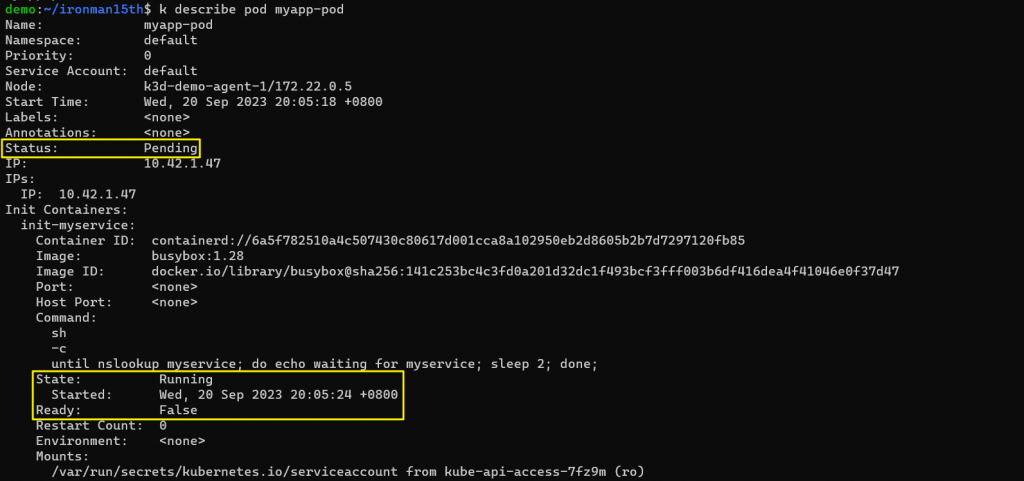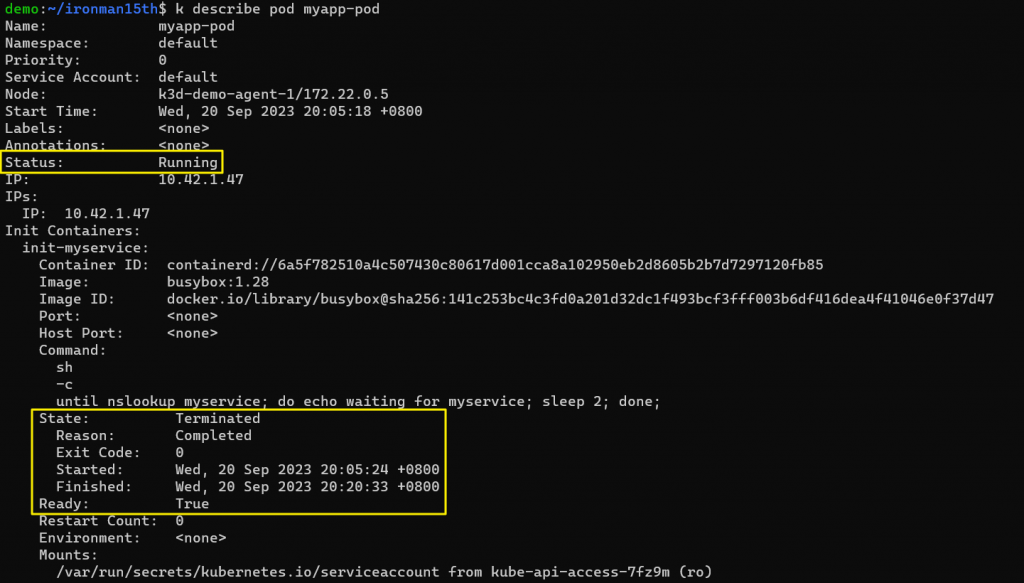通常一個 Pod 內只會有一個應用程式在運行,這也比較有利管理及規模的控制。不過有的應用程式較為複雜,例如可能需要先做些前置作業,或是有輔助的程式,這時能在 Pod 中使用多個 container,以 container 為單位來建構出這個應用,但又都放在同一個 Pod 中。Kubernetes 提供了 init container 及 multi container 的功能讓一個 Pod 中能運行多個 container。
Pod 中可運行多個 container,在 spec containers這邊設置。
apiVersion: v1
kind: Pod
metadata:
name: hello-world-pod
spec:
containers:
- name: container1
image: chihhuiw/nodejs-helloworld:1.0.0
imagePullPolicy: Always # 預設是 IfNotPresented
command: ["node", "/app/index.js"]
args: ["3001"]
ports:
- containerPort: 3001
volumeMounts:
- mountPath: /demo1
name: demo-volume
- name: container2
image: chihhuiw/nodejs-helloworld:1.0.0
imagePullPolicy: Always
command: ["node", "/app/index.js"]
args: ["3002"]
ports:
- containerPort: 3002
volumeMounts:
- mountPath: /demo2
name: demo-volume
volumes:
- name: demo-volume
emptyDir: {}
這邊我設置了 arguments,可以在啟動 node js 程式時指定要跑的 port。所以這邊我跑了兩個 container 但使用不同的 port,因同一個 port 只能被一個 container 使用。
同一個 Pod 中的兩個 containers 可直接用 localhost: port 連接。來測試看看:
kubectl exec -it hello-world-pod -c container1 -- /bin/sh
-c : 指定 container 名稱,如果一個 Pod 裡面只有一個 Container 可忽略
container 1
container 2
因 Pod 建立時會被 assign 一組 IP,同一個 Pod 內的 container,不能監聽同樣的 port。這種情況下只會有一個容器綁定到那個 port,第二個容器則無法成功啟動。
apiVersion: v1
kind: Pod
metadata:
name: nginx-pod
labels:
name: nginx-pod
spec:
containers:
- name: nginx-1
image: nginx
ports:
- containerPort: 80
- name: nginx-2
image: nginx
ports:
- containerPort: 80

kubectl describe pod nginx-pod →
另外上面的 yaml 我們還有定義了 volume 這個 field,這是用來設置 pod 存取檔案的資訊。可以發現 volume 的使用是 Pod level 的,也就是同一個 Pod 只會有一個 volume。在這邊我們使用 emptyDir 的方式掛載 volume。
當 Pod 被分配到節點上,一個 emptyDir volume 就會被建立起來,並持續到 Pod 死掉。而這個 directory 一開始會是空的,可以被掛到多個 container 中。應用場景會是一些暫時性的使用,例如快取。
而在每個 container 中可設定這個 volume 要掛載進 container 中的哪個位置。這兩個 container 能互相對同一個目錄下的檔案做操作。
一樣來觀察看看 -
上圖我執行了以下指令
demo1 folder → 如 yaml 所設置test.txt ,其中包含 test 的內容demo2 folder → 如 yaml 所設置demo2 底下是否有剛才建立的 test.txt
test.txt
/demo1
ls 發現原本的 text.txt 不見了在啟動 pod 的時候,其中 containers 的啟動是不分順序的。但如果我們有些工作希望能在主要 container 啟動之前執行,就可以使用 initial container,例如先從 repo 拉下最新的程式碼 etc。
如同 containers 的 section 一樣,一個 pod 可以有多個 initContainer,會照順序執行。要注意的是,要等前一個 initContainer 運行成功,才會跑下一個。init container 如果運行失敗,kubelet 會重啟這個 pod 直到 init container 啟動成功。但如果 restartPolicy (Pod level) 設置為 Never ,這個 Pod 就會被視為啟動失敗。
apiVersion: v1
kind: Pod
metadata:
name: init-containers-pod
spec:
containers:
- name: myapp-container
image: busybox:1.28
command: ["sh", "-c", "echo The app is running! && sleep 3600"]
initContainers:
- name: init-myservice
image: busybox:1.28
command:
[
"sh",
"-c",
"until nslookup myservice; do echo waiting for myservice; sleep 2; done;",
]
- name: init-mydb
image: busybox:1.28
command:
["sh", "-c", "until nslookup mydb; do echo waiting for mydb; sleep 2; done;"]
上面的程式碼有主要的 container 一個,init containers 兩個。
init-myservice 執行的指令是,執行 nslookup myservice ,如果沒有找到就印出 waiting for ...,找到後等 2 秒結束。
而 init-mydb 則會等 init-myservice 執行成功後,才執行。一樣會執行 nslookup mydb 後,如果沒找到就印出字樣,找到後等 2 秒後結束。
init containers 執行完畢後,才會開始跑 myapp-container 。
但第一階段我們還沒有建立 myservice & mydb ,所以 init containers 應該是無法完成它的任務,整個 Pod 會是 Pending 的狀態。
利用 kubectl describe pod myapp-pod 觀察
可以看到 init-service State = Running,但後續的 containers 狀態都還是等待中。
利用 k logs myapp-pod -c init-myservice 檢查特定 container log 會發現 init-myservice 很努力的在找 myservice 不過找不到
後面的 containers 還沒跑起來所以看不到 log
再來我們建立 myservice & mydb service 給這兩個 container 連
apiVersion: v1
kind: Service
metadata:
name: myservice
spec:
ports:
- protocol: TCP
port: 80
targetPort: 9376
---
apiVersion: v1
kind: Service
metadata:
name: mydb
spec:
ports:
- protocol: TCP
port: 80
targetPort: 9377
這時再檢查 pod status,變成 Running 了
利用 kubectl describe pod myapp-pod 觀察
Init containers State = Terminated,主要的 Container State = Running
一樣用 kubectl logs mypod -c <container name> 看 log。
這張是 kubectl logs myapp-pod -c init-myservice 的一部分 output,可以看出有印出 waiting for myservice 的句子,最後找到 myservice 後則停止。
這張是 kubectl logs myapp-pod -c init-mydb 的 output,因我們同時建立了兩個 service,而 init-mydb 這個 container 又是接在 init-service 後面啟動,這時 nslookup 直接找到 mydb 這個 service 了,就沒有印出 waiting for mydb
最後看一下主要 container 的 log
等 init containers 執行成功後,主要的 container 也順利啟動了
nslookup <service name> 的部分、後面那串 default.svc.cluster.local 的介紹,Service 的部分會講到(應該,逃避中QQ)。
Reference
https://kubernetes.io/docs/concepts/workloads/pods/
https://kubernetes.io/docs/tasks/access-application-cluster/communicate-containers-same-pod-shared-volume/
https://kubernetes.io/docs/concepts/workloads/pods/init-containers/
